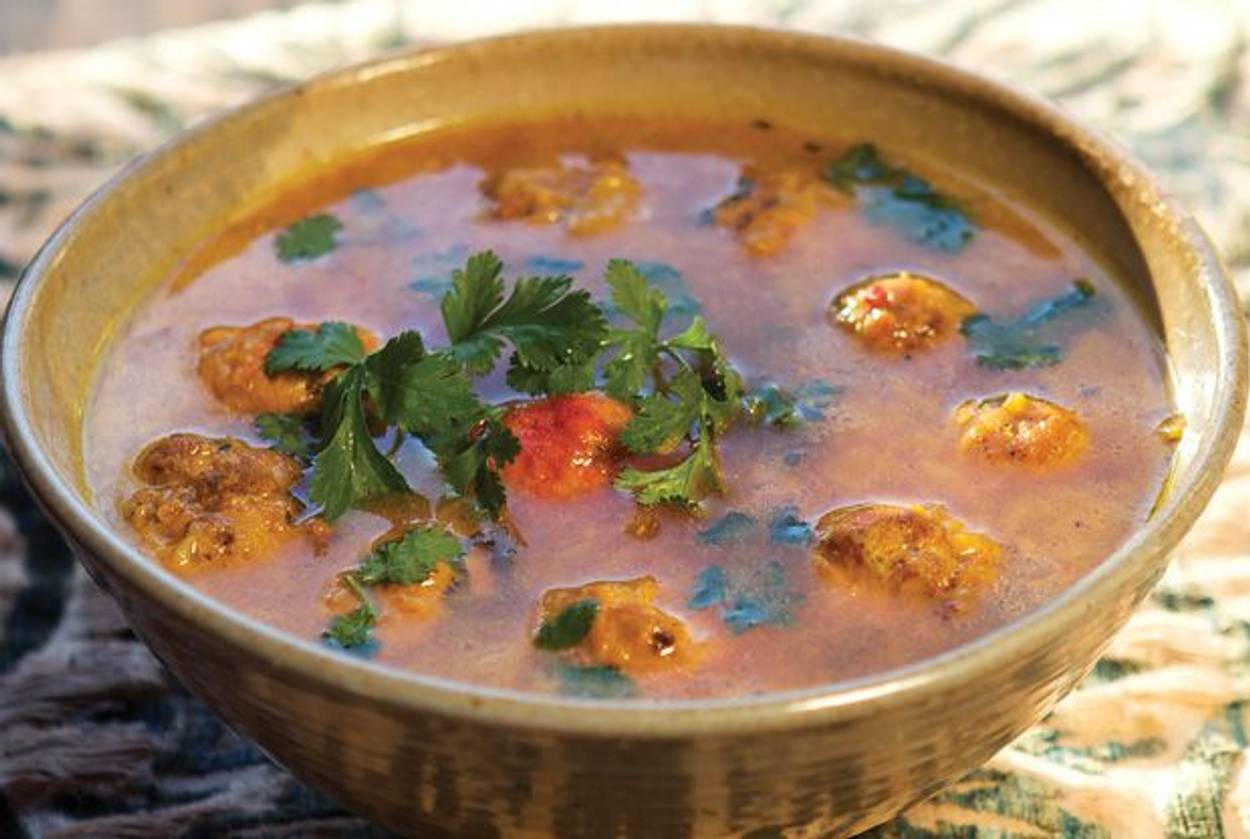Sweet and Sour
From crispy rice to chickpea dumplings, Persian Jewish cuisine offers new and different ways to celebrate the New Year




When American Jews usher in Rosh Hashanah next week, most will dip an apple in honey for a sweet new year. Some will eat a date, and others will display a bowl of pomegranates on the table.
But when Persian-American Jews sit down to celebrate, their tables will be laden with an abundance of symbolic foods. In fact, they call the Rosh Hashanah meal a Seder, and the Aramaic blessings they recite follow a particular order. Cookbook author Reyna Simnegar, whose beautiful book Persian Food From the Non-Persian Bride and Other Kosher Sephardic Recipes You Will Love came out earlier this year, says these customs originated more than 2,500 years ago.
“We first dip an apple in honey, then we tear a piece of leek—meaning to rip the enemy apart—and then throw the leek over our shoulder,” she said. Included on the table is fried zucchini, black-eyed peas, lamb’s head, tongue or a fish head, roasted beets, and dates. “In Iran the cooked lungs of a cow or lamb were used,” she told me. “But here, we put something fluffy like popcorn on the table.”
Even before the destruction of the First Temple in 586 B.C.E., Jews were living in Babylon, which would later become the Persian Empire under Cyrus the Great. The Persian world offered a enormous variety of food. “When you ask for oranges, pistachios, spinach, or saffron, you are using words derived from the Persian,” said Najmieh Batmanglij, author of cookbooks like Food of Life and doyenne of Persian cooking in America, who noted that Persia was a great trading post in the ancient and medieval worlds. “The land was the first home of many common herbs, from basil to cilantro, and to scores of familiar preparations, including sweet and sour sauces and kebabs.”
As Persian Jews traveled, so did their food—a taste for meat with sweet and sour sauce, egg frittatas with greens called koukous, and especially rice. Jewish traders from Persia brought rice to ancient Israel at the time of the Second Temple. By the eighth century C.E., a network of Jewish traders called the Radhanites emerged and maintained international trade routes between the Christian and Islamic worlds. They combed the Mediterranean and the Indian Ocean for new foods, furs, and spices. First described by the postmaster of the caliph of Baghdad in the ninth century, the Radhanites brought a revolutionary international trade network to the area, trading products like papyrus, textiles, wine, spices, and olive oil. Their four major trading routes began in Iberia or France and, each passing through various Jewish communities, ended in the silk route of China or India, 500 years before Marco Polo traveled east.
One Persian Jewish dish often served at Rosh Hashanah and Shabbat is gundi. Simnegar calls it the Persian matzoh ball. This large chickpea dumpling, made with either ground chicken, turkey, or beef, and flavored with turmeric, cardamom, and sometimes cumin, is cooked in chicken soup. For Persian Jews, the holidays would not be complete without it.
A series of chorosht—sweet and sour stews with meat, vegetables, and fruit—are also on the menu of festive Persian Jewish meals, along with a salad of fresh dill, cilantro, scallions, and radishes. But the centerpiece is usually a variation of perfectly cooked rice, served with a crispy tadiq, or crust. Like pasta for Italians, rice sets the standard for a Persian cook.
The story of how Simnegar came to write about Persian cuisine is a fascinating one. Born in Venezuela, she spent her early years as a Catholic and discovered her family’s converso past as an adolescent. She moved to Los Angeles to study at UCLA, and while there she met her husband, Sammy, a Persian Jew. Simnegar’s mother-in-law was the one who taught her the lexicon of Persian Jewish cooking, which she serves today to her five small children. I promise you that her quince stew with veal, served with Persian rice and decorated with carrots and oranges, will enhance your Rosh Hashanah table. These dishes serve as a wonderful reminder of how Jewish traders centuries ago made the culinary world smaller. As they moved so did their recipes and traditions, enhancing Jewish tables for generations to come.
Joan Nathan is Tablet Magazine’s food columnist and the author of 10 cookbooks including King Solomon’s Table: a Culinary Exploration of Jewish Cooking from Around the World.